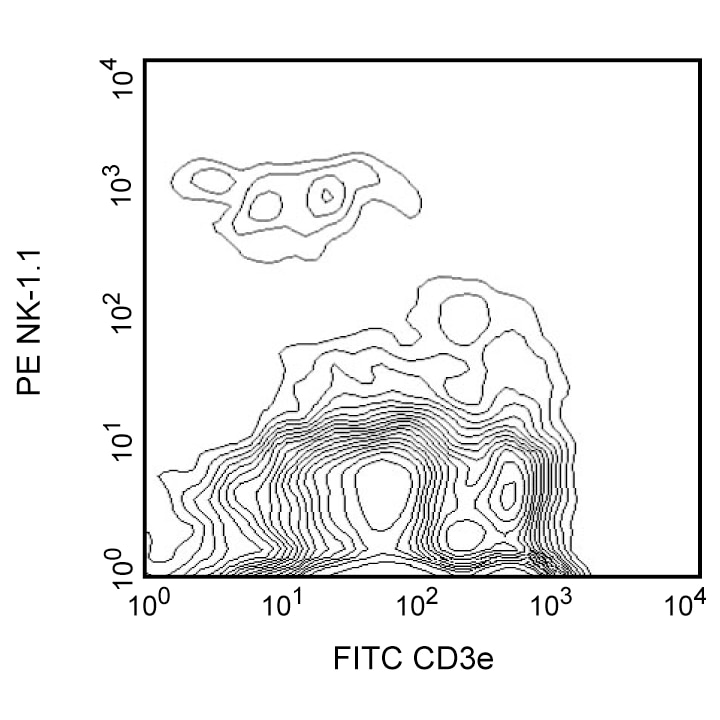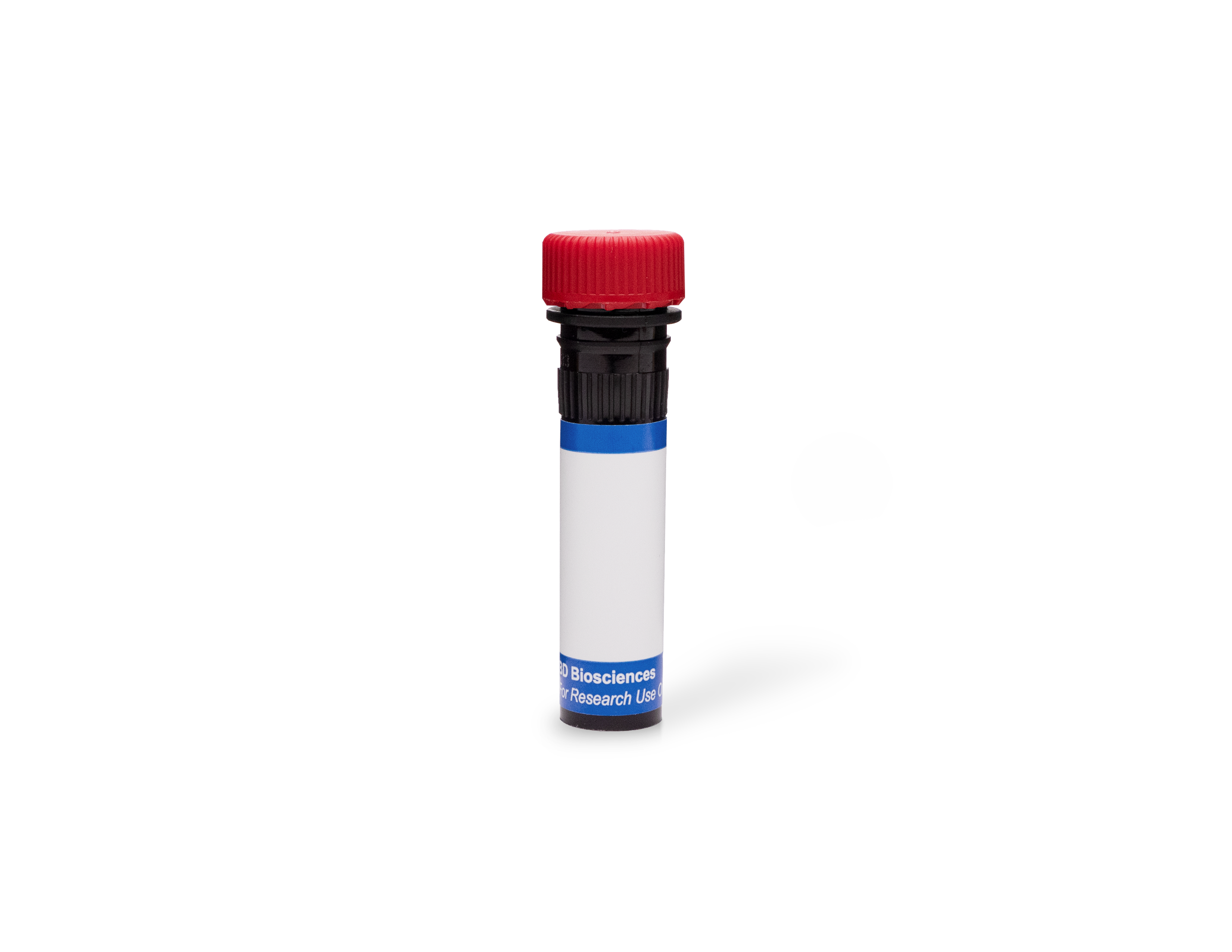首页
BD Pharmingen™ PE Mouse Anti-Mouse NK-1.1



1/2

品牌: BD Pharmingen
 用小程序,查商品更便捷
用小程序,查商品更便捷



 收藏
收藏
 对比
对比 咨询
咨询反应种属:
Mouse (QC Testing)
Mouse (QC Testing)
来源宿主:
Mouse C3H x BALB/c IgG2a, κ
Mouse C3H x BALB/c IgG2a, κ
产品介绍
产品信息
耦联标记
PE

抗原名称
NK1.1

宿主
Mouse C3H x BALB/c IgG2a, κ

免疫原
Mouse NK-1+ Spleen and Bone Marrow Cells

简单描述
In the mouse, at least three members of the
Klrb
(
K
iller cell
l
ectin-like
r
eceptor, subfamily
b
; formerly
NKR-P1
) gene family have been identified (
Klrb1a/NKR-P1A, Klrb1b/NKR-P1B,
and
Klrb1c/NKR-P1C
); but in the human gene family, a single homologue has been designated
KLRB1, NKR-P1A, or CD161
. The KLRB1/NKR-P1 family of proteins are type-II-transmembrane C-type lectin receptors. KLRB1C/NKR-P1C activates NK-cell cytotoxicity, while KLRB1B/NKR-P1B functions as an inhibitory receptor. KLRB1B/NKR-P1B protein has intracellular
I
mmunoreceptor
T
yrosine-based
I
nhibitory
M
otif (ITIM), while KLRB1C/NKR-P1C lacks ITIM and activates via association with Fc Receptor γ chain. Strikingly, KLRB1B/NKR-P1B and KLRB1C/NKR-P1C share 96% amino acid sequence identity in their extracellular C-type lectin domains. The PK136 antibody reacts with the NK-1.1 surface antigen (CD161c) encoded by the
Klrb1c/NKR-P1C
gene expressed on natural killer (NK) cells in selected strains of mice (eg, C57BL, FVB/N, NZB, but not A, AKR, BALB/c, CBA/J, C3H, C57BR, C58, DBA/1, DBA/2, NOD, SJL, 129) and the CD161b antigen encoded by the
Klrb1b/NKR-P1B
gene expressed only on Swiss NIH and SJL mice, but not on C57BL/6. Expression of KLRB1C/NKR-P1C protein is correlated with the ability to lyse tumor cells in vitro and to mediate rejection of bone marrow allografts. The NK-1.1 marker is useful in defining NK cells; however, the antigen is also expressed on a rare, specialized population of T lymphocytes (NK-T cells) and some cultured monocytes. Plate-bound PK136 mAb, in combination with low concentrations of IL-2, induces proliferation of a subset of NK cells.
This antibody is routinely tested by flow cytometric analysis. Other applications were tested at BD Biosciences Pharmingen during antibody development only or reported in the literature.

商品描述
In the mouse, at least three members of the
Klrb
(
K
iller cell
l
ectin-like
r
eceptor, subfamily
b
; formerly
NKR-P1
) gene family have been identified (
Klrb1a/NKR-P1A, Klrb1b/NKR-P1B,
and
Klrb1c/NKR-P1C
); but in the human gene family, a single homologue has been designated
KLRB1, NKR-P1A, or CD161
. The KLRB1/NKR-P1 family of proteins are type-II-transmembrane C-type lectin receptors. KLRB1C/NKR-P1C activates NK-cell cytotoxicity, while KLRB1B/NKR-P1B functions as an inhibitory receptor. KLRB1B/NKR-P1B protein has intracellular
I
mmunoreceptor
T
yrosine-based
I
nhibitory
M
otif (ITIM), while KLRB1C/NKR-P1C lacks ITIM and activates via association with Fc Receptor γ chain. Strikingly, KLRB1B/NKR-P1B and KLRB1C/NKR-P1C share 96% amino acid sequence identity in their extracellular C-type lectin domains. The PK136 antibody reacts with the NK-1.1 surface antigen (CD161c) encoded by the
Klrb1c/NKR-P1C
gene expressed on natural killer (NK) cells in selected strains of mice (eg, C57BL, FVB/N, NZB, but not A, AKR, BALB/c, CBA/J, C3H, C57BR, C58, DBA/1, DBA/2, NOD, SJL, 129) and the CD161b antigen encoded by the
Klrb1b/NKR-P1B
gene expressed only on Swiss NIH and SJL mice, but not on C57BL/6. Expression of KLRB1C/NKR-P1C protein is correlated with the ability to lyse tumor cells in vitro and to mediate rejection of bone marrow allografts. The NK-1.1 marker is useful in defining NK cells; however, the antigen is also expressed on a rare, specialized population of T lymphocytes (NK-T cells) and some cultured monocytes. Plate-bound PK136 mAb, in combination with low concentrations of IL-2, induces proliferation of a subset of NK cells.
This antibody is routinely tested by flow cytometric analysis. Other applications were tested at BD Biosciences Pharmingen during antibody development only or reported in the literature.

同种型
Mouse C3H x BALB/c IgG2a, κ

克隆号
克隆 PK136 (RUO)

产品详情
PE
R-Phycoerythrin (PE), is part of the BD family of Phycobiliprotein dyes. This fluorochrome is a multimeric fluorescent phycobiliprotein with excitation maximum (Ex Max) of 496 nm and 566 nm and an emission maximum (Em Max) at 576 nm. PE is designed to be excited by the Blue (488 nm), Green (532 nm) and Yellow-Green (561 nm) lasers and detected using an optical filter centered near 575 nm (e.g., a 575/26-nm bandpass filter). As PE is excited by multiple lasers, this can result in cross-laser excitation and fluorescence spillover on instruments with various combinations of Blue, Green, and Yellow-Green lasers. Please ensure that your instrument’s configurations (lasers and optical filters) are appropriate for this dye.

PE
Yellow-Green 488 nm, 532 nm, 561 nm
496 nm, 566 nm
576 nm
应用
实验应用
Flow cytometry (Routinely Tested)

反应种属
Mouse (QC Testing)

目标/特异性
CD161b,c (NK-1.1)

背景
别名
Klrb1b, CD161b, Nkrp1b; Klrb1c, CD161c, NK1.1, Nkrp1c

制备和贮存
存储溶液
Aqueous buffered solution containing ≤0.09% sodium azide.

保存方式
Aqueous buffered solution containing ≤0.09% sodium azide.
参考图片
Two-color analysis of NK-1.1 expression on splenocytes. C57BL/6NHsd splenocytes were incubated simultaneously with FITC-conjugated anti-mouse CD3e mAb 145-2C11 (Cat. No. 553061/553062) and PE-conjugated mAb PK136. NK-1.1+ CD3e- NK cells and NK-1.1[dim] CD3e+ NK-T cells are detected. Flow cytometry was performed on a BD FACScan™ flow cytometry system.
声明 :本官网所有报价均为常温或者蓝冰运输价格,如有产品需要干冰运输,需另外加收干冰运输费。






 危险品化学品经营许可证(不带存储) 许可证编号:沪(杨)应急管危经许[2022]202944(QY)
危险品化学品经营许可证(不带存储) 许可证编号:沪(杨)应急管危经许[2022]202944(QY)  营业执照(三证合一)
营业执照(三证合一)